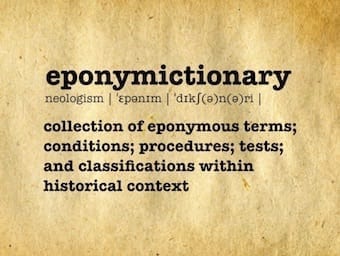
Stellwag Sign
Stellwag Sign: decreased, incomplete or infrequent blinking in patients with exophthalmic goitre (Graves-Basedow disease). Stellwag sign may also seen in progressive supranuclear palsy, and in dysthyroid eye disease

Stellwag Sign: decreased, incomplete or infrequent blinking in patients with exophthalmic goitre (Graves-Basedow disease). Stellwag sign may also seen in progressive supranuclear palsy, and in dysthyroid eye disease

Pendred syndrome: autosomal recessive genetic disorder (chromosome 7q31), characterized by congenital sensorineural deafness and goitre.

Ashman phenomenon (1947) aberrant ventricular conduction, usually of RBBB morphology, which follows a short RR interval and preceeded by a relatively prolonged RR interval.
Burst fracture of the atlas (C1). Often occurs as a result of an axial load to the spine from a direct blow to the vertex of the head

The history of pyloric stenosis and the Ramstedt Operation (1912) for pyloromyotomy - surgical correction of hypertrophic pyloric stenosis, involving longitudinal splitting of the hypertrophic pylorus and leaving the defect open.

Hirschsprung disease is a developmental disorder characterized by the absence of ganglia (aganglionosis) in the distal colon, resulting in functional obstruction

Arnold-Chiari malformation (Type II Chiari malformation) associated with myelomeningocele. Julius Arnold (1835-1915) and Hans Chiari (1851-1916)

Budd–Chiari syndrome. Hepatic venous outflow obstruction. George Budd (1808 - 1882) and Hans Chiari (1851-1916)

Kienböck Disease: Avascular necrosis (osteonecrosis) of the lunate leading to abnormal carpal motion. Descriebd 1910 by Robert Kienböck (1871-1953)

Lauge-Hansen classification of ankle injuries (1950) - predictable fracture patterns defined by injury mechanism and resultant radiological findings

Terry-Thomas Sign: increased distance between the scaphoid and the lunate (scapholunate space) Described by Frankel in 1977

Bankart Lesion: Antero-inferior detachment of the glenoid labrum associated with first-time traumatic anterior shoulder dislocations.